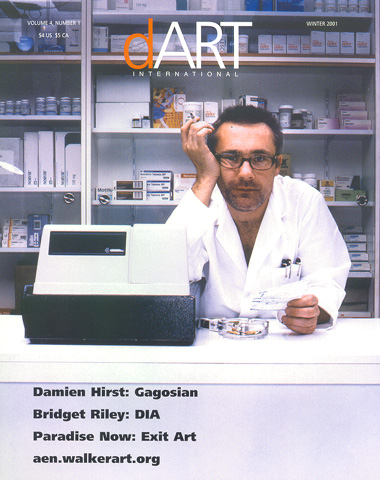
Damien Hirst
Theories, Models, Methods, Approaches, Assumptions, Results, and Findings at Gagosian
by Clayton Campbell
This is, without question, the first great show of the new century. Damien Hirst has been absent from the New York scene for the past four years (Sensations displayed his older, familiar work) and now, this amazing installation, which fills the gargantuan Gagosian gallery space, effectively raises the bar for contemporary artists. Hirst, like Francis Bacon before him, gets down and dirty with the "brutality of fact" and comes up with the smartest, most mature and elegant work of his life. He indeed inherits the mantle of Bacon, and should be seen alongside Bacon as one of the most important contemporary artists of our time.
Hymn is the centerpiece of the show, a 20-foot-high bronze "biological" body that is stripped bare to display the organs. It stands like a Colossus of Rhodes over a punch list of hot-button topics the exhibit pushes. Big science could be the leitmotif of Hirst's project, the kind of science dealing with the body, pharmacology, hospitals, and the plain, horrible facts of mortality.
To the side of Hymn is The Void, which consists of large glass cabinets filled with garbage bags of handcrafted pills. Herein lie the magic bullets of our science: pills to pop for health; prayers for something non-invasive; magic to combat aging, ill health, reality, and death's door.
Across the way is the aptly named Death Is Irrelevant. A skeleton lies horizontally pinioned in a cross of glass. By way of an air propulsion system, a ping-pong ball hovers in the air above its empty eye sockets. Hirst maintains a black humor throughout, leavening the seriousness of his investigation with one visual pun after another.
The state of hovering above the fine line between life and death or between true creativity and intellectual sloth is amplified by the installation work after which the show is named. Two large glass cases are filled with hundreds of ping-pong balls bounced around by air compressors like the numbered balls in a TV lotto. If life seems like a wilfully random raffle, Love Lost and other large tableau vitrines make things deadly specific. In Love Lost the vitrine is filled with water, and fish swim around a gynecological examination table. The invasive aspects of science, especially in the gynecologist's office, carry sexual undertones reeking of secrecy. Missing from Hirst's vitrines are literal and over-the-top carved up carcasses. Instead, we see evidence of medical crimes much like the evidence left behind in Bacon's paintings of unspeakable acts and sadomasochistic sexual appetites. On a table next to the examining table are the gynecologist's rings, taken off in order to better examine the patients. Fish swim around in this tableau, Hirst says, because "Women smell like kippers!"
Not much is sacred in his world view, and as usual, he doesn't disappoint his detractors by voicing descriptive opinions like the one above. Perhaps he is not the most articulate or sensitive guy in the world, but his art speaks volumes about our fears, hopes, desires, and times.
The show goes on and on. Large enamel grid paintings cover the walls of the five rooms and visually link the installation in an effective, simple manner. There are 25 major pieces in this show, a lifetime's achievement for some artists. The craft is impeccable, the through-line apparent, the catalogue excellent. His hand is in everything. Altogether, this exhibit sets a new standard for installation artists.
In the end, a wistfulness peeks through the expensive presentation. Adam and Eve Banished, discreetly put in the farthest room, is a vitrine containing two bodies on hospital gurneys, the dead bodies (dummies) covered with sheets. A cheese sandwich with a bite taken out (the missing piece from which man was made) sits forlornly on the body of Eve. This isn't General Hospital. It is the loss of the sacredness surrounding the awareness of death, the expulsion revisited. For one night this October, the center of the art universe was at 24th Street and 11th Avenue in New York. Bravo, Mr. Hirst.
|